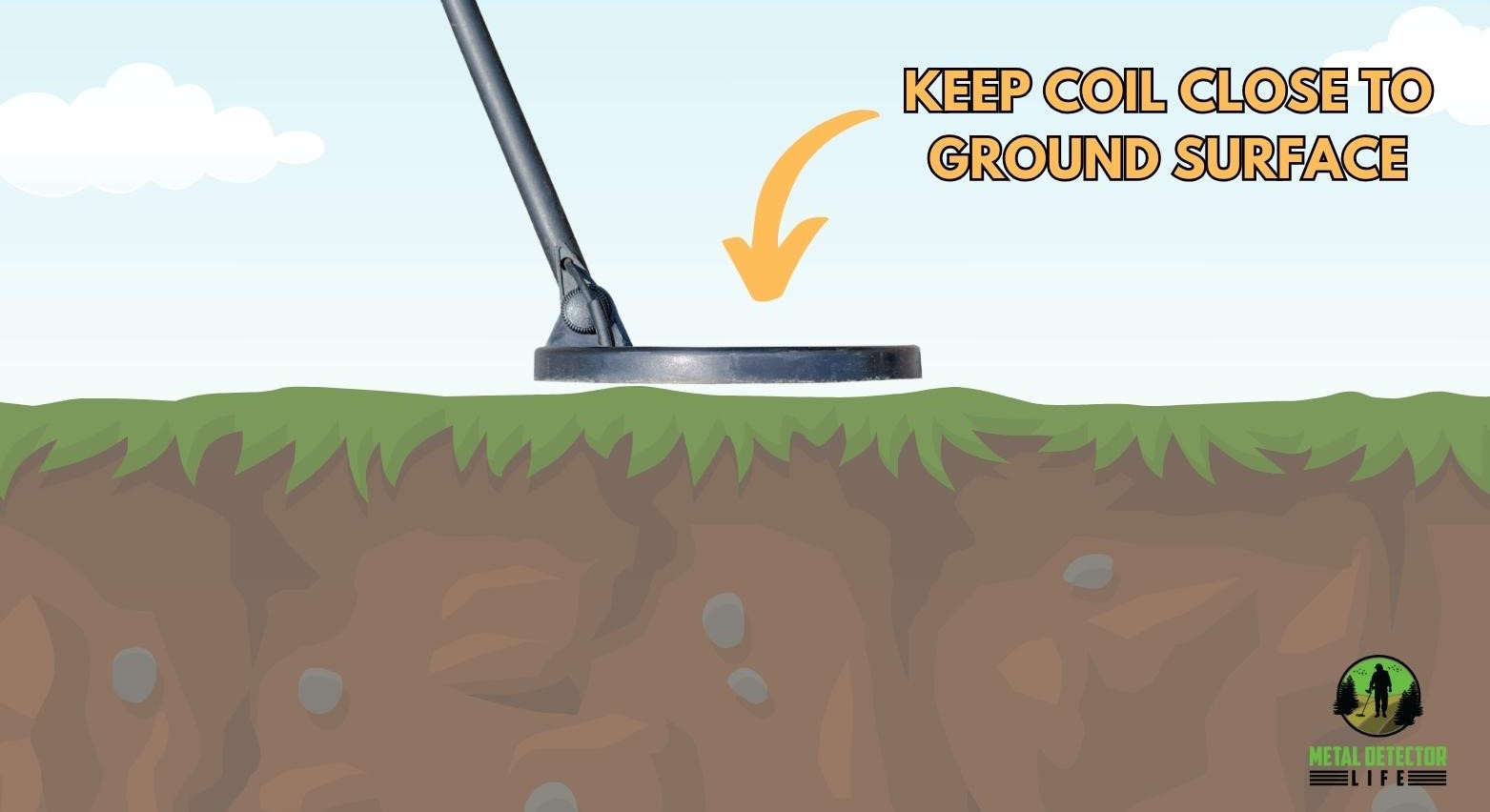Many metal detector enthusiasts hope to unearth a genuine treasure using their metal detectors. As a result, they often focus on locating metals such as silver, gold, platinum, or titanium.
However, many valuable items like certain coins, bullet casings, jewelry, and other religious artifacts contain another, less well-known metal: brass.
So, the question on the minds of many detectorists is…
…Can a metal detector detect brass?
Yes, brass can be detected by a metal detector. A metal detector detects disruptions in the emitted electromagnetic field. Brass is, in fact, a metal alloy of copper and zinc. Since brass contains metallic components, it will disrupt the electromagnetic field of the metal detector, causing the detector to beep.
Are you curious about the fantastic brass objects you can discover with a metal detector? In this blog, we’ll explore all the aspects you need to know to uncover brass treasures with your metal detector. Keep reading if you’re eager to find brass objects with your detector!
What is brass actually?

Before we delve into how your metal detector detects brass, it’s essential to understand what brass actually is.
Brass is a metallic alloy composed of copper and zinc. The ratio of copper to zinc can vary, resulting in different types of brass with distinct properties.
Generally, brass contains approximately 15 to 45% zinc and 55 to 70% copper. Brass closely resembles gold due to its yellow to golden color. Brass finds extensive use due to its corrosion resistance, ease of workability, good heat conductivity, and long lifespan.
What valuable brass items can you discover with a metal detector?
Not many people are aware that you can discover highly valuable brass objects with a metal detector. Examples of valuable brass items you can find include:
- Antique Coins: Many Roman, Ottoman, and medieval coins, such as the dupondius and sestertius, were minted using zinc and copper alloys. These coins are now sold for approximately $200 each!
- War Relics: Many bullet casings, military buttons, and badges from past wars are made of brass. A significant number of these items are considered collectibles, making them quite valuable!
- Vintage Jewelry: Numerous vintage jewelry pieces, like rings, brooches, and bracelets, incorporate brass in their designs. Finding one of these gems could potentially earn you a substantial sum!
- Decorative Items: Many doorknobs, figurines, and candle holders contain brass. Discovering one of these antique items in good condition can fetch you a significant amount, ranging from hundreds to thousands of dollars.
- Brass Buckles: Old belt buckles, buttons, and fasteners were often crafted from brass. These are certainly items you can uncover with a metal detector!

The realm of metal detecting offers the potential to discover concealed treasures, and brass items are certainly no exclusion. Whether you’re an experienced detectorist or embarking on your journey, remain vigilant for these valuable brass discoveries!
It’s important to note that the value of these brass objects can vary significantly depending on factors such as their condition, age, rarity, style, and design.
Is brass magnetic or not?
Brass is composed of an alloy of zinc and copper. Both zinc and copper are non-magnetic metals. This means that brass is also non-magnetic. You can easily confirm this by attempting to attract a piece of brass with a magnet, and you’ll observe that the brass doesn’t adhere to the magnet.
Fortunately, a metal detector is capable of detecting non-magnetic metals like brass. Therefore, a metal object doesn’t need to be magnetic to be detected by a metal detector.
Will a metal detector find brass shell casings?

Yes, a metal detector will pick up brass bullet casings. However, it’s crucial to exercise extreme caution when handling them. Some bullets may not have been fired, and they could still contain gunpowder, posing a potential risk of explosion.
Additionally, in certain countries, such as the Netherlands, it is not allowed to excavate and take away bullet casings. To determine whether it is permissible in your area to recover brass bullet casings, it’s advisable to contact your local authorities for guidance.
Apart from brass bullet casings, you can also uncover a variety of other war-related items using a metal detector, including uniform accessories, military medals, musket balls, flashlights, binoculars, telescopes, compasses, coins, and utensils from wartime.
Will a metal detector find brass knuckles?
Yes, a metal detector can detect brass knuckles because they are made of metal alloys such as zinc and copper. This means that brass knuckles can disturb the electromagnetic field of the metal detector. Therefore, the metal detector will start to beep when it detects a brass knuckle.
If you come across a brass buckle, it most likely dates back to the late 19th or early 20th century. If this brass buckle happens to be in pristine condition, you could potentially make anywhere from tens to hundreds of euros with a bit of luck.
How to detect brass with a metal detector?
It’s great to know that you can discover highly valuable brass items with a metal detector. However, it’s even more crucial to understand how to find these items.
To uncover brass items with a metal detector, there are several key steps to follow:
1. Locate a suitable detecting area
2. Select the appropriate metal detector
3. Adjust the settings properly
4. Apply the correct search technique.
5. Count on some good fortune
1. Locate a suitable detecting area

The most crucial step in finding brass is selecting an appropriate detection location. After all, there must be brass objects present at the location if you intend to discover them with your metal detector.
In general, it’s advisable to choose places where people have lived or congregated in the past. Some excellent locations for metal detecting may include:
- Old Fields: Areas where farming or cultivation took place in the past.
- Parks: Public recreational areas that have seen a lot of foot traffic over the years.
- Historical Sites: Locations with historical significance, which often hold relics of the past.
- Near Old Town Centers: Proximity to older village or town centers.
- Along Sandy Paths or Roads: Paths and roads that have been used for a long time.
Before you start detecting at any of these places, there’s one rule you must always remember: you need permission from the property owner. Therefore, always seek the owner’s consent before beginning your metal detecting adventure!
2. Select the appropriate metal detector
In fact, there are numerous suitable metal detectors you can use since they are all capable of detecting brass.
However, there are a few things to consider. The metal detector should have a discrimination option, and it should also feature sensitivity settings. With these two crucial settings, it becomes much easier to locate brass.
In the table below, I’ve listed some highly suitable metal detectors for finding brass!








3. Adjust the settings properly
Generally, two key settings must be configured correctly to find brass effectively. These settings are:
- Discrimination Function
- Sensitivity Function
Let’s start with the discrimination function. Most metal detectors offer a choice between ferrous and non-ferrous modes.
Since brass is a non-ferrous metal, it’s advisable to use the non-ferrous mode on your metal detector. Typically, the metal detector emits high-pitched tones when it detects non-ferrous metal objects.
In addition, it’s essential to set the sensitivity at the appropriate level. Sensitivity determines how quickly your metal detector responds to metal objects in the ground.
It’s crucial to use the highest sensitivity possible, just below the point where the metal detector starts producing false signals. If your metal detector continues beeping excessively, consider reducing the sensitivity level.

4. Apply the Correct Search Technique
Once you have the right location, the appropriate metal detector, and the correct settings, it’s time to start searching. Using the right search technique is crucial.
In simple terms, this means keeping the coil horizontal to the ground surface at all times. Try to keep the coil as close to the ground as possible to achieve maximum detection depth.
Avoid swinging too vigorously from side to side; instead, make smooth and controlled motions. Consider using a skid plate to protect the detector coil during your searches!

5. Count on some good fortune
Metal detecting remains a hobby that demands luck, patience, and consistency. Luck, in particular, plays a crucial role. If you don’t immediately stumble upon valuable items, don’t be discouraged!
Keep trying, and hope that someday luck will be on your side, allowing you to detect a valuable brass object!
What is the best metal detector to detect brass?
To select a suitable metal detector for brass detection, it’s crucial to consider the following factors:
- The metal detector should operate at a high frequency.
- The metal detector should include sensitivity and discrimination features.
- Opt for a metal detector with a smaller search coil.
- Optionally, the metal detector may also feature a ground balance function.
Starting with the high frequency, brass is a non-ferrous metal, meaning it lacks iron content. Therefore, you should opt for a metal detector with a high frequency. Ideally, consider choosing a multi-frequency metal detector like the Minelab Equinox 700 or the Minelab Equinox 800.
Furthermore, the metal detector should include sensitivity and discrimination functions. These two features allow you to accurately set the detector to ignore iron, ensuring it detects only metals with properties similar to brass. Fortunately, most detectors come equipped with these settings.
It’s advisable to select a metal detector with a smaller search coil (though not mandatory, it’s more convenient). The reason for this is that smaller search coils are better at detecting small objects like brass.
Lastly, it’s beneficial to opt for a metal detector with a ground balance function. This feature enables the metal detector to disregard ground mineralization, ensuring it detects only brass objects.
Based on these criteria, I recommend four excellent metal detectors for brass detection:
In the table below, you’ll find an overview of the features and prices of each detector. If you’re looking for a more budget-friendly option, consider the Bounty Hunter TK4 Tracker IV.








How should I properly clean brass after finding it?
There are several ways to clean brass items found with a metal detector, but I’ll explain the easiest method for cleaning brass objects:
1. Create a Soapy Solution
Start by creating a soapy solution. Mix lukewarm water with a small amount of soap. You can do this in a sink, a basin, or a bucket.
2. Soak the Brass
Place the discovered brass object in the soapy water and let it soak for approximately 10 to 15 minutes. This soaking period helps loosen dirt and tarnish from the brass item.
3. Gently Scrub and Rinse
Use a soft cloth or a gentle sponge to scrub the brass object. Avoid using sharp objects to prevent damage to the item. Alternatively, you can use a toothbrush for detailed cleaning. After scrubbing, rinse the brass thoroughly with clean water.
4. Carefully Dry
Pat the brass object dry with a soft towel. Ensure it is completely dry to prevent water spots or tarnish from forming.
Remember that some old brass items may have a patina or aged layer that collectors find appealing. Therefore, carefully consider the age and value of the item before attempting to clean or restore its shine. In some cases, it’s better to preserve that patina.
How do I identify brass?
The easiest way to determine if the object you’ve found is brass is by examining its magnetic properties. Brass is not magnetic, which means the object should not be attracted to magnets.
So, grab a magnet and see if the object is attracted to it or not. Additionally, brass is generally heavier than other metals. If your object is noticeably heavy, there’s a good chance it’s brass.
Furthermore, brass has a distinct golden color that can be a giveaway. You can also use a chemical reaction to identify brass. Applying a drop of acid to a small area of the object’s surface and observing if it oxidizes or changes color can indicate brass.
Lastly, you can listen to the sound the object makes. When you gently tap brass with another metal or a hard object, it produces a clear and ringing sound. People often describe it as a “bell-like” sound.
How do I distinguish brass from gold and copper?
Brass, due to its color, closely resembles both gold and copper. Fortunately, there is a way to differentiate brass from both gold and copper.
While all three metals can appear yellow, gold typically exhibits a brighter and more intense shade of yellow compared to brass and copper. Brass usually has a less vibrant color and may appear somewhat orange or reddish. Copper, on the other hand, lacks the same brightness and tends to have a reddish or brownish hue.
Furthermore, the density of gold is greater than that of both brass and copper. If you can measure the volume and weight of the metal, you can calculate the density to assist with identification.
Moreover, brass and copper will tarnish and corrode over time, resulting in a greenish patina (verdigris). Gold, being highly resistant to corrosion and tarnish, remains shiny and free from patina.
Finally, gold will not react to nitric acid, whereas brass and copper will cause a reaction. However, always exercise extreme caution when using chemical tests and follow safety guidelines. Therefore, I discourage the use of such tests due to their potential hazards.
What sounds does a metal detector produce when it detects brass?
As mentioned earlier, brass is a non-ferrous metal. Generally, a metal detector will produce high, loud, and consistent tones when it detects a non-ferrous metal.
This means that your metal detector will primarily generate high, loud, consistent, and clear sounds when it detects brass. Therefore, concentrate mainly on these signals when searching for brass.
Can you make money with detecting brass?
Now that you know how to find brass, it’s also interesting to consider whether you can make money by detecting brass with a metal detector.
The price for brass typically ranges from $7 to $10 per kilogram. Therefore, you would need to find a significant amount of brass to make a substantial income. However, it’s possible to come across valuable brass items like coins, bullet casings, or jewelry, which can indeed fetch a good sum of money!
Fortunately, there are also many other ways to make money with metal detecting. For more information on these opportunities, I recommend checking out my other blog post.
Frequently Asked Questions
A brass probe for metal detecting is like a special tool you can hold in your hand. It helps you find and dig up metal things hidden under the ground. It’s made of strong brass, which helps it find metal things better when you’re searching for treasures or ancient stuff.
Yes, wear gloves to prevent injuring your hands on sharp brass objects. Also, watch out for uneven terrain and be mindful of extreme heat or cold. Always go well-prepared!
Metal detector enthusiasts often discover common brass items such as bullets, buttons, buckles, coins, jewelry, and a range of artifacts, including military insignia, decorative items, and antique objects.
No, you cannot detect for metal everywhere with a metal detector. Firstly, you need permission from the property owner to use a metal detector anywhere. Furthermore, searching in water bodies, historical sites, and some national parks is restricted. Always consult your local authorities before metal detecting.

